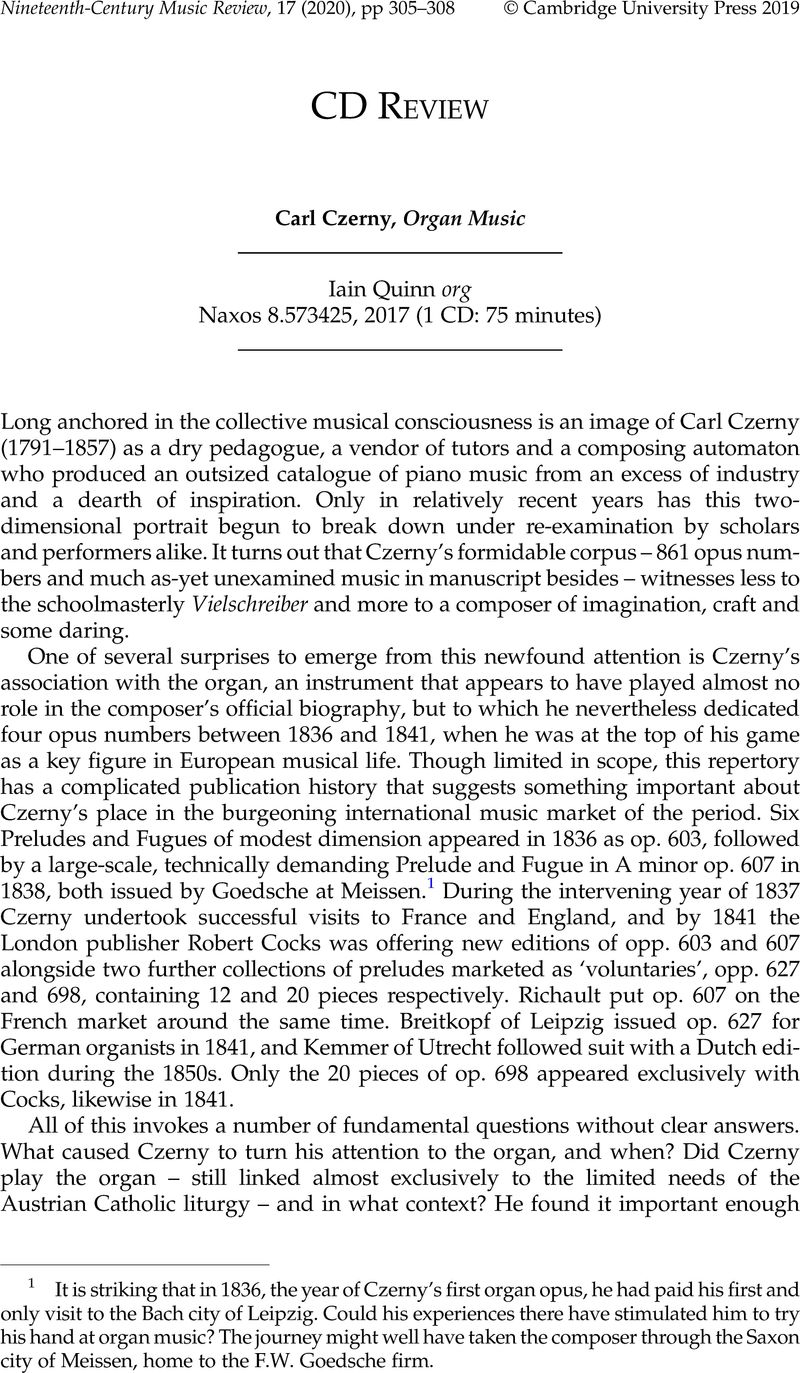No CrossRef data available.
Published online by Cambridge University Press: 09 May 2019

1 It is striking that in 1836, the year of Czerny's first organ opus, he had paid his first and only visit to the Bach city of Leipzig. Could his experiences there have stimulated him to try his hand at organ music? The journey might well have taken the composer through the Saxon city of Meissen, home to the F.W. Goedsche firm.
2 ‘My father was educated in a Benedictine monastery near Prague. At the same time he received rather thorough training in music, since he possessed a good voice and always had to sing the soprano solo in church. Occasionally he had to play the organ as well’. Czerny, Carl, Erinnerungen aus meinem Leben, ed. Kolneder, Walter (Baden-Baden: Valentin Koerner, 1968), 7Google Scholar (my translation).
3 ‘Meine musikalischen Erinnerungen aus der Zeit meiner Kindheit und Jugend’, published in Bottegal, Attilio, ‘Carl Czerny's Recollections: An Overview and an Edition of Two Unpublished Autograph Sources’, in Beyond The Art of Finger Dexterity: Reassessing Carl Czerny, ed. Gramit, David (Rochester, NY: University of Rochester Press, 2008), 42Google Scholar (my translation). As Bottegal notes, the latter musician is likely the organist Ignaz Wenzel Rafael (1762–1799), in which case Czerny would have encountered him at a very young age.
4 Czerny, Carl, School of Practical Composition; or, Complete Treatise on the Composition of All Kinds of Music op. 600, vol. 1, trans. Bishop, John (London: Robert Cocks, n.d.), 128Google Scholar (emphasis in original). As models for the composer, Czerny prints the opening bars of Bach's big fugues BWV 544, 545 and 686.
5 ‘Wherever an extremely rapid tempo is indicated, this is, of course, meant only for the pianoforte. When playing passages so marked on the organ, the tempo must be moderated very decidedly’. Czerny, Carl, Preface to Johann Sebastian Bach, The Well-Tempered Clavier (New York and London: G. Schirmer, 1893)Google Scholar. Czerny also allowed for different keyboard instruments in some compositions for organ. The English subtitle to op. 603 specifies that the piece is ‘in the Church Style for the Piano Forte or Organ’, whereas the German subtitle for op. 627 reads ‘im gebundenen Styl für die volle Orgel, das Pianoforte oder Physharmonika’. Marketability is a factor here, but so is a certain universal competence assumed to play a part in the education of keyboardists. Note as well that the full-organ preludes of op. 627 in the German version become Twelve Soft Voluntaries for the Organ in a comprehensive listing of Czerny's works supervised by Cocks in ca. 1860, and that neither of these comport with the actual English title Twelve Introductory or Intermediate Voluntaries. For the Cocks listing, see (among other sources) Czerny, Erinnerungen aus meinem Leben, 55–76.
6 The disk acts as a companion of sorts to Quinn's two-volume edition of the complete organ works: Czerny, Carl, Preludes and Fugues for Organ and Voluntaries for Organ (Middleton, WI: A-R Editions, 2011)Google Scholar. An essay by Quinn, , ‘Czerny and the Organ: Pragmatism, Prestige and Performance Practice’, in Interpreting Historical Keyboard Music: Sources, Contexts and Performance, ed. Woolley, Andrew and Kitchen, John (Farnham: Ashgate, 2013), 173–83Google Scholar, largely reproduces the front matter from the 2011 editions and dwells on the music's early reception in England. Organists have had access to some of this music before: Otto Biba had edited the big Prelude and Fugue op. 607 and selections from opp. 603 and 698 in Czerny, Carl, Ausgewählte Orgelwerke, Diletto Musicale 671 (Vienna and Munich: Doblinger, 1977)Google Scholar.
7 Czerny, School of Practical Composition, vol. 1: 114.
8 Czerny had improvised on ‘Gott erhalte Franz den Kaiser’ for Princess Victoria at Kensington during his 1837 visit to England. His variations on the tune for piano and string quartet, published as op. 73, keep to G major.
9 One may reasonably hear further allusions: to the subject of the Fugue in A minor from Book 2 of The Well-Tempered Clavier (BWV 889), with which Czerny's op. 607 shares a key, and to the subject of Johann Georg Albrechtsberger's Fugato in E minor (IJA 10), advanced by Czerny as a model in the School of Practical Composition, vol. 1: 119.